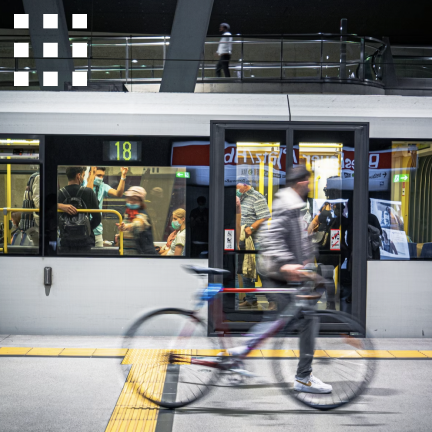The future of digital payments in the
public transport industry.
The future of digital payments in the
public transport industry.


COVID-19 hit the public transport industry hard in 2020, as measures to contain the virus led to an almost complete shutdown of travel worldwide.
However, ridership has generally recovered from pre-pandemic levels. The pandemic has also had positive effects on public transport, with research showing that disruptions can be a catalyst for shifts towards more sustainable transport behaviours. Many countries have pledged to help support vital public transport services to ensure they remain popular, and this can only help improve the service and work towards a sustainable future.
During COVID-19, consumers began following advice to reduce cash handling and pursuit of tap on, tap off (TOTO) and the replacement of smart cards with digital apps has followed. This has exposed opportunities for the digital travel purchase journey, and payments are a big part of this.
Despite this, not all public transportation in Europe accepts digital payments even though complex payment options often act as a barrier to travel and are the cause of many complaints. Navigating public transport systems can be intimidating, especially in unfamiliar places or in cities with large, complex networks, but technology can make it simpler and more convenient.
How do digital payments work?
Public transportation has evolved into an essential component of infrastructure worldwide, and to ensure its ongoing efficiency, it must be future-proofed. This is where digital payments play a crucial role. The introduction of payment innovation enhances the overall customer experience, rendering long queues and fumbling for change relics of the past.
But how exactly do digital payments revolutionise public transport? In the context of electronic and mobile ticketing, two distinct approaches emerge: closed loop and open loop systems.
In a closed loop system, passengers are provided with a credit card-sized smart card that they can conveniently top up with funds, as exemplified by the Madrid Transport Consortium card. On the other hand, open loop payments allow passengers to utilise their existing contactless cards or devices, ranging from debit cards to wearables. This approach offers the same level of seamless travel as the closed loop system but eliminates the need for an additional card and the requirement to remember to top it up. Passengers simply need to tap their devices on the sensors and by doing so, the transaction is effortlessly completed.


Why are digital payments the future of public transport?
COVID-19 shaped urban mobility experiences and expectations. Public transit has always been a vital part of how people get to work or school, run errands, and travel to leisure activities. However, the pandemic has pushed many riders to challenge how they pay their fares. The speed, security, and ease of digital payments have helped shift global consumers’ payment preferences. Let’s explore these benefits further.
Seamless, systematic and suitable: People demand seamless and efficient payment processes, and this expectation extends to paying for public transport. In 2019, a staggering 45% of individuals said they would feel more positively towards public transport if contactless was introduced, highlighting the need for change. Fortunately, the industry has taken note and begun implementing more convenient payment options, significantly enhancing the overall customer experience. Given that public transport is an integral part of daily life for a significant portion of the global population— 56.6% of the global population rely on public transport—it’s crucial that these journeys seamlessly integrate into their everyday routines.
Getting the best bargain: While passengers using traditional payment methods are burdened with the task of researching the most affordable tickets, contactless payments guarantee that consumers never pay more than necessary. Digital payment systems offer the convenience of a pay-as-you-go approach, accurately calculating fares for each individual journey. With the implementation of fare-capping, this pay-as-you-go system takes into consideration all trips made within a day or week, ensuring that passengers do not exceed the maximum fare limit. It's worth noting that Europeans, on average, allocate 13.2% of their total consumption expenditure to transportation, making it the second largest household expense in the EU after housing. Given the ongoing cost-of-living crisis, which has impacted many of us significantly, the opportunity to save money wherever possible becomes an invaluable advantage.
“Public transit has always been a vital part of how people get to work or school, run errands, and travel to leisure activities. However, the pandemic has pushed many riders to challenge how they pay their fares.”
Time is money: Research has consistently demonstrated that each additional minute of our daily commute takes a toll on our personal wellbeing, satisfaction, and overall happiness. So, the availability of a user-friendly payment method, such as contactless payments, becomes crucial in minimising travel time for customers. Remarkably, average anxiety levels increased with each additional minute of the commute. Recognising this, the industry must prioritise the implementation of more time-efficient payment options to shape the future of public transportation. The faster commuters can complete their journeys, the more enhanced their overall experience becomes.

From public to private
Digitalisation has not only revolutionised the public transport industry but also the private one. Gone are the days when hailing a cab on the side of the road meant hoping you had enough cash or finding a driver who accepted card payments.
Now, we find ourselves in the era of innovative ride-hailing services like Uber, FreeNOW, or Cabify, among others. These companies have completely transformed the urban mobility landscape, enabling users to effortlessly hail rides through intuitive mobile apps and make payments in advance.
What sets these companies apart is their commitment to providing customers with a seamless, efficient, and flexible transportation experience. By allowing users to book rides through their user-friendly apps, they have streamlined the payment process, sparing passengers the hassle of repeatedly entering their payment details. The rise of shared payment methods, family cards and prepaid cards has also meant that parents can pay for their children’s ride and users have the option to collectively share the payment for a single trip.
What sets these companies apart is their commitment to providing customers with a seamless, efficient, and flexible transportation experience. By allowing users to book rides through their user-friendly apps, they have streamlined the payment process, sparing passengers the hassle of repeatedly entering their payment details. The rise of shared payment methods, family cards and prepaid cards has also meant that parents can pay for their children’s ride and users have the option to collectively share the payment for a single trip.
How can fintechs get involved?
Fintech companies hold a pivotal position in shaping the future of payment systems, driving innovation within the industry. As the public transport sector strives to become more agile and innovative, fintech companies offer valuable support in digitalising payment systems, benefiting both passengers and transport companies.
At Getnet, we actively embrace innovation. Thats why we have pioneered projects across Europe and Latin America. For example in 2022 in Spain we joined forces with Renfe to provide direct access and payment at turnstiles using a bank card. This streamlined approach enables passengers to board trains effortlessly by simply presenting their physical bank card or mobile device at the turnstile, eliminating the need to purchase tickets in advance. This innovation not only saves time but also reduces costs.
In Madrid we worked with Mastercard to digitalise payments on buses and enabled payment gateway and card top-up via an app, while in Seville we have made it possible for card payments to be implemented at the barriers of the metro system. As a company we are proud to say that these projects have been successful, as we aim to use digital payments to transform the transport industry.
In Madrid we worked with Mastercard to digitalise payments on buses and enabled payment gateway and card top-up via an app, while in Seville we have made it possible for card payments to be implemented at the barriers of the metro system. As a company we are proud to say that these projects have been successful, as we aim to use digital payments to transform the transport industry.
In 2021 we worked with Visa to implement a contactless payment system on three lines of Mexico City’s Metrobús system, meaning almost one million users can now access the lines using contactless credit and debit cards, as well as smartphones and smart watches.
With the assistance of fintech, the public transport industry can ensure its seamless adaptation to modern times and proactively prepare for the future.
You can find out more about Getnet’s global payment solutions here.
